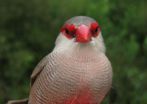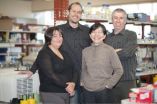(Press-News.org) A large waistline and high triglyceride levels in pregnant women could be an early screening tool for gestational diabetes, according to a study published in CMAJ (Canadian Medical Association Journal) (pre-embargo link only) http://www.cmaj.ca/embargo/cmaj100378.pdf.
Gestational diabetes is a significant public health concern, with potential negative effects on women and their babies, yet tests to diagnose are costly, time-consuming and unpleasant for pregnant women. As well, results are not available until relatively late in pregnancy, at about six months. Previous studies have shown that obesity before pregnancy is linked to an increased risk of gestational diabetes. There is a need for early, simple screening tools, especially with the trend of increasing obesity around the world.
In a study of 144 French-Canadian women under age 40 from Chicoutimi Hospital in Quebec, Canada, researchers found that an increased waistline and high triglyceride levels were linked to higher glucose intolerance levels in later pregnancy. Nineteen of the women had a previous history of gestational diabetes and 143 of 144 had a normal fasting glucose in their first trimester.
"We found that the simultaneous presence of abdominal obesity and hypertriglyceridemia in the first trimester is associated with a significantly increased risk of glucose intolerance later in pregnancy," writes Dr. Diane Brisson, Université de Montréal and Chicoutimi Hospital with coauthors.
They note that the sample size was modest and homogenous but suggest further research with larger, more diverse populations.
"Measurement of waist girth in combination with triglyceride concentrations in the first trimester of pregnancy may be useful in the improvement of early screening for gestational diabetes," conclude the authors.
INFORMATION:
MEDIA NOTE: Please use the following public links after the embargo lift:
Research http://www.cmaj.ca/cgi/doi/10.1503/cmaj.100378
Contact for interviews: Dr. Diane Brisson, diane.brisson@ecogene21.org after September 14
In pregnancy, a large waistline and high triglycerides: Early screen for gestational diabetes
2010-09-20
ELSE PRESS RELEASES FROM THIS DATE:
New driver of T cell leukemia growth
2010-09-20
NKX3.1, a protein that suppresses the development of prostate tumors, promotes the growth of a different type of tumor in the blood, according to an article published online on September 20 in the Journal of Experimental Medicine (www.jem.org).
Paul-Henri Romeo and colleagues find that TAL1, a protein abundantly expressed in approximately 40% of patients with T cell acute lymphoblastic leukemia (T-ALL), drives expression of NKX3.1. Eliminating NKX3.1 halted the growth of TAL1-expressing T-ALL cells in culture and after injection into mice.
It's not yet clear how ...
Preserving nerve cells in motor neuron disease
2010-09-20
A team of researchers, led by Scott Oakes, at the University of California, San Francisco, has identified a way to prevent symptom onset, weight loss, and paralysis and extend survival in a mouse model of amyotrophic lateral sclerosis (ALS; also known as Lou Gehrig's disease), providing a new avenue of research for the development of therapeutics for ALS and other motor neuron diseases.
ALS and other motor neuron diseases are neurological disorders that selectively affect nerve cells that control voluntary muscle activities such as speaking, walking, breathing, swallowing, ...
JCI online early table of contents: Sept. 20, 2010
2010-09-20
EDITOR'S PICK: Preserving nerve cells in motor neuron disease
A team of researchers, led by Scott Oakes, at the University of California, San Francisco, has identified a way to prevent symptom onset, weight loss, and paralysis and extend survival in a mouse model of amyotrophic lateral sclerosis (ALS; also known as Lou Gehrig's disease), providing a new avenue of research for the development of therapeutics for ALS and other motor neuron diseases.
ALS and other motor neuron diseases are neurological disorders that selectively affect nerve cells that control voluntary ...
Lightweight true random number generators a step closer
2010-09-20
The widespread use of true random number generators (TRNGs) has taken a step closer following the creation of the most lightweight designs to date by researchers at Queen's University Belfast's Institute of Electronics, Communications and Information Technology (ECIT).
Members of the Institute's cryptography research team have produced a series of circuits that are up to 50 per cent smaller than anything else currently available. Optimised for digital circuits, FPGA and ASIC, they push efficiency to the limit by using just one logic gate, one look-up table and four transistors ...
Protein may advance Parkinson's by preventing neurons from clearing debris
2010-09-20
A protein linked to Parkinson's disease may cause neurodegeneration by inhibiting autophagy—the process in which cells digest some of their contents—according to a study in the September 20 issue of the Journal of Cell Biology (www.jcb.org).
Autophagy serves to clear a variety of toxic waste from cells, including misfolded proteins and defective mitochondria. These two types of cellular trash accumulate in neurons from Parkinson's patients, suggesting that autophagy could be impaired in these cells. A commonly amassed protein in Parkinson's disease is alpha-synuclein, ...
Magnetic attraction for fish, crabs?
2010-09-20
SEATTLE – Super-sized electromagnetic coils are helping explain how aquatic life might be affected by renewable energy devices being considered for placement along America's coastal waters and in the nation's rivers.
Scientists with the Department of Energy's Pacific Northwest National Laboratory are examining whether a variety of fish and invertebrates change their behavior during and after exposure to an electromagnetic field similar to those produced by marine and hydrokinetic power devices that capture energy from ocean waves, tides, currents and rivers. Research began ...
Female fish abandoned by males to raise offspring on their own
2010-09-20
Caring for children can be a tough job, particularly if you are a female cichlid fish.
Native to the crater lakes of Nicaragua, cichlid fish look after their young by defending them against would-be predators. While male and female cichlid fish generally share parental responsibilities, research shows that this is not always the case.
Conducted by an international team of researchers that included two biologists from Monash University, and published in the journal Behavioral Ecology and Sociobiology, new research has shown that male cichlid fish have a propensity ...
Secrets of birds' sexual signals revealed
2010-09-20
Patterned feathers, previously thought to be used only for camouflage in birds, can play an important role in attracting a mate and fending off rivals, a University of Melbourne study reveals.
Ms Thanh-Lan Gluckman, co-author of the paper and Masters of Philosophy student from the Department of Zoology at the University of Melbourne, Australia, said this finding brought a new perspective to research in animal communication and evolution.
"The implication of this study is that feathers don't need to be bright and showy to be used in sexual signalling and hence this changes ...
Protein behind development of immune system sentinels identified
2010-09-20
A protein called PU.1 is essential for the development of dendritic cells, the sentinels of the immune system, Walter and Eliza Hall Institute researchers in Melbourne, Australia, have shown.
Dendritic cells (DC) are immune cells that present proteins from foreign invaders, such as viruses, to the killer T cells of the immune system, allowing a full immune response to be mounted against the invaders.
Researchers from the Immunology division have been studying dendritic cells and how different molecules regulate their development.
Dr Li Wu said one of the molecules ...
Citizen scientist
2010-09-20
We are all scientists now, thanks to SETI@home, Galaxy Zoo, The Great Sunflower Project, Folding@home and counltess other projects that allow individuals to take part in scientific research directly or indirectly. In the case of SETI@home and Folding@home one shares one's computer CPU with the researchers, whereas Galaxy Zoo is more about active involvement with the classification of stellar objects in images of the night sky, for instance.
Now, writing in the International Journal of Organisational Design and Engineering, US researchers have mapped out an approach to ...



